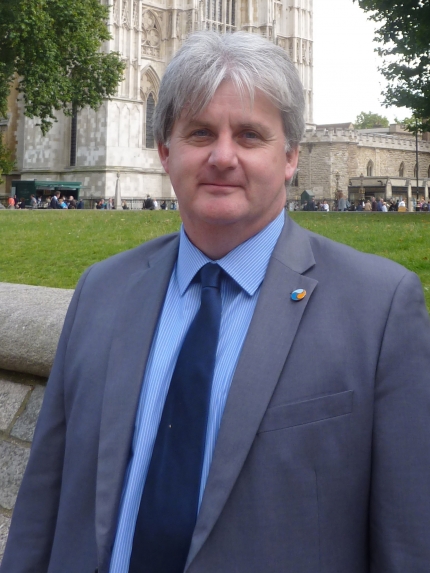19 October, 2017 – UK-based Coldharbour Marine, a manufacturer of ballast water treatment systems (BWTS) based on unique inert gas technology, has launched a new treatment process designed specifically for large dry bulk vessels and ore carriers. The system uses the company’s existing inert gas based GLD™ treatment plant to meet the needs of large bulk carriers, which often ship large volumes of ballast water in upper wing tanks and discharge it directly into the sea.

Andrew Marshall, CEO Coldharbour Marine Ltd
The IMO International Convention for the Control and Management of Ships’ Ballast Water and Sediments presents specific challenges for operators of bulk carriers by setting out specific discharge standards which must be met.
Andrew Marshall, Coldharbour Marine’s Chief Executive, explains that most system technologies work by treating the ballast water at the point it is taken on board at the cargo discharge port and usually incorporate a filtration process and chemical dosing. Delays during ballast loading due to filtration issues or system breakdown are only one of the potential pitfalls, he says.
“Big bulk carriers are usually deployed on long haul routes and lengthy ballast voyages can lead to significant organism regrowth. Ships fitted with in-line BWTS technologies cannot guarantee full compliance with discharge standards at the end of a long ballast voyage.”
In contrast, Coldharbour’s system is not an in-line process and does not treat ballast water at uptake. Instead it is an in-voyage process, so there are no filters and no potential problems relating to flow rates, pressure drops, or power consumption during ballasting.
“Some try to ignore the regrowth issue,” Marshall continues, “but the fact is that no BWTS technology is 100% kill effective. If treatment is only undertaken during uptake, the few organisms that survive will thrive and multiply over a long ballast voyage in the food rich, benign environment of the ballast tank. The longer the ballast leg, the greater the risk of significant regrowth, meaning that ballast water could easily fail to meet discharge standards several weeks later, especially during high biota growth periods such as spring and summer.”
A ballast voyage between China and Brazil typically takes about six weeks, and ballast water could well require re-treatment before discharge to avoid potential delays by port state control, financial penalties, or even off-hire. Ships failing to meet requirements repeatedly might be difficult to charter, while their owners could face reputational damage
.
Coldharbour’s in-voyage treatment without filtration ensures that ballast water discharged complies with IMO standards, regardless of the water’s condition at intake and the length of the ballast voyage.
The Coldharbour solution is especially appropriate for bulk carriers because it addresses stability issues specific to the ship type, Marshall explains. For example, bulkers sometimes load extra ‘heavy weather’ ballast water in cargo holds, which inevitably faces contamination by cargo residues. In-line systems would find this water hard to process and could be damaged by it. In this case, Coldharbour has developed a pipe circuit to allow ballast to be pumped from the various tanks through robust gas lift diffusion (GLD) units mounted in the machinery space – instead of in-tank, meaning that water can be returned to the tanks via multiple outlets to ensure that contents are stirred and treated.
“Just as in the in-tank installation, the GLD units simultaneously remove oxygen and temporarily lower the pH of the ballast water, a combination which is fatal for most marine organisms,” Marshall explains. The remaining organisms such as enteric bacteria are dealt with by Coldharbour’s patented technology of gas induced ultrasonic cellular disruption which also takes place inside the GLD units.
“Now that the IMO’s Ballast Water Convention has entered force, vigilant port states will be watching bulk carrier operators closely,” Marshall says. “Operators of these vessels have no time to lose in assessing how they will meet Convention requirements.”
Visit us at KORMARINE 2017, Busan, Korea, 24-27 October, stand #3B53
About Coldharbour Marine Ltd
Coldharbour Marine Limited is a UK-based design, engineering business with nearly four decades of inert gas and water treatment experience. The company has a long history in the inert gas generation sector, and has in recent years developed Sea Guardian™ – a clean, green, compact “third generation” technology for use in LNG carriers and large tankers.
Sea Guardian™ inert gas generators incorporate a range of patented features that ensure stable, reliable, low maintenance operation and they are also integral to Coldharbour’s award-winning GLD™ ballast water treatment system.
Key features of the GLD™ system are that treatment takes place in-tank and in-voyage and without the need for any form of in-line filtration. This approach ensures no disruption to terminal operations during ballasting and no risk of re-growth of marine organisms on long ballast voyages. With the GLD™ system, large vessels are now guaranteed to arrive at terminals ready to load or off-load ballast without the risk of delay caused by BWTS operational difficulties.
The system is fully type-approved by IMO, with testing undertaken by both the UK’s Maritime and Coastguard Agency and Lloyd’s Register. It also has US Coast Guard Alternate Management Systems acceptance and is currently undergoing the full US Coast Guard type approval process.
For further information please contact:
Paul Hubbard
Account Manager
JLA Media
paul.hubbard@j-l-a.com
+44 208 405 6343
